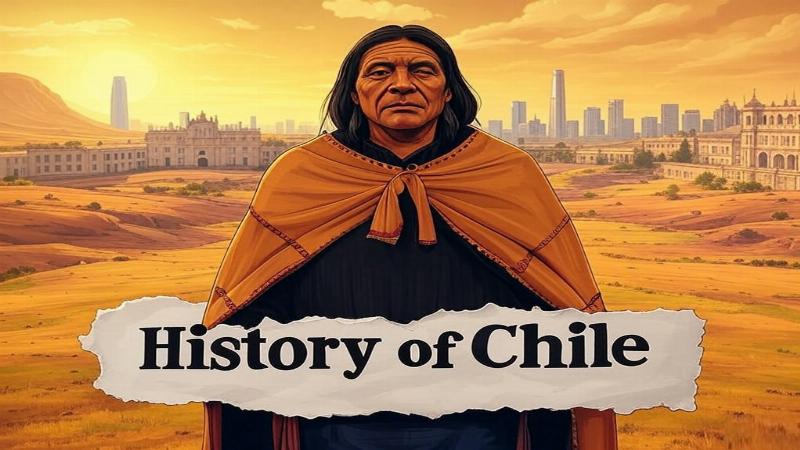Place for ads

Chile, a slender ribbon of land along South America’s Pacific coast, is a nation where towering Andes meet endless deserts and rugged shores. Covering 756,096 square kilometers, it stretches between Peru, Bolivia, Argentina, and the Drake Passage, its 6,435-kilometer coastline a testament to its geography. Known today for its copper, wine, and vibrant democracy, Chile’s history blends Indigenous resilience, colonial ambition, and modern triumphs. In this article, we’ll journey through Chile’s past, from its earliest days to its contemporary identity, uncovering the milestones that have shaped this striking country.
Chile’s human story begins around 14,500 BCE, when hunter-gatherers crossed into South America—Chinchorro mummies from Arica, dated to 7000 BCE, are the world’s oldest, their intricate wrapping a marvel. These coastal peoples fished the Humboldt Current, leaving shell middens near Antofagasta.
By 3000 BCE, Neolithic farmers settled—pottery at Tiliviche shows quinoa and llama herding. The Atacama Desert’s aridity preserved relics—Monte Verde’s 14,800-year-old camp reveals wood tools and seaweed diets. Mapuche ancestors arrived later, their Araucanian language taking root in Chile’s fertile south.
By 500 CE, distinct cultures flourished—Diaguita in the north crafted ceramics, trading with Tiwanaku across Bolivia. The Atacameño (Likanantaí) mined copper
Place for ads
The Inca reached Chile by 1470 under Tupac Yupanqui—roads stretched to Santiago, but the Mapuche resisted beyond the Maule River. Their fierce independence—huasos on horseback—kept the south free, a legacy of defiance that would echo through centuries.
In 1535, Diego de Almagro probed Chile for Spain—finding no gold, he retreated. Pedro de Valdivia returned in 1540, founding Santiago in 1541—Mapuche under Lautaro razed it in months, launching a 300-year war. Valdivia’s 1554 death at Tucapel cemented their resistance.
Chile became a Spanish captaincy-general—Concepción and Valparaíso grew, exporting wheat and hides. Encomienda enslaved Indigenous peoples—80% died by 1600 from smallpox and labor. Jesuits built missions, but the Arauco War raged—Spain’s grip stayed weak south of the Bío Bío River.
Napoleon’s 1808 invasion of Spain sparked Chile’s push for freedom—Bernardo O’Higgins and José Miguel Carrera led the charge. The 1810 First National Junta in Santiago defied Spain—battles like Rancagua (1814) faltered, but O’Higgins’ 1817 Andes crossing with José de San Martín won at Chacabuco.
Independence came February 12, 1818—O’Higgins ruled as Supreme Director, abolishing slavery. The 1821 expulsion of royalists at Maipú sealed it—Chile stretched south, subduing Mapuche by the 1880s. Ports boomed—Valparaíso rivaled San Francisco during the California Gold Rush.
The 1879 War of the Pacific—over nitrate-rich Atacama—pitted Chile against Peru and Bolivia. Victories at Iquique and Tarapacá gave Chile Antofagasta and Bolivia’s coast—Santiago’s wealth soared, funding railways and schools. German immigrants settled the south—Osorno’s wooden homes echo their mark.
Civil war struck in 1891—President José Manuel Balmaceda’s reforms clashed with Congress; the navy won, birthing a parliamentary era. Nitrate faded—synthetic fertilizers tanked exports—but copper rose—Chuquicamata’s mines, opened in 1915, hinted at Chile’s next boom.
The 1925 Constitution restored presidential power—Arturo Alessandri’s labor laws tamed unrest. World War I and II boosted trade—Allies bought copper, though Chile stayed neutral until 1943. Salvador Allende’s 1970 election—world’s first Marxist president by vote—promised socialism.
Allende nationalized copper—U.S. firms like Anaconda lost billions—sparking CIA-backed unrest. The 1973 coup—Gen. Augusto Pinochet bombed La Moneda, Allende died—ushered in dictatorship. Pinochet’s 1973–1990 rule killed 3,000, exiled 200,000—free markets thrived, but dissent bled.
The 1988 plebiscite ousted Pinochet—Patricio Aylwin’s 1990 win restored democracy. Copper—40% of exports—and wine from Maule Valley fueled growth—Santiago’s skyline soared. Michelle Bachelet (2006–2010, 2014–2018)—Chile’s first woman president—pushed education and equality.
Today, Chile’s 19 million people shine—90% literacy, stable GDP—but 2019 protests over inequality rocked streets, echoing Mapuche demands. Culture thrives—Pablo Neruda’s poetry, cueca dances—and the Atacama’s telescopes scan stars. Earthquakes and mining scars test resilience.
Chile’s history is a South American epic—from Mapuche spears to colonial swords, independence to modern might. Its deserts whisper of ancient lives, its cities pulse with promise. As Chile strides forward, its past fuels a legacy of courage and contrast.
Place for ads